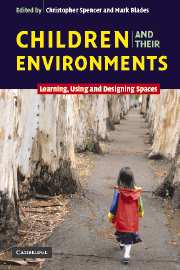An introduction
Published online by Cambridge University Press: 23 October 2009
Summary
In this book, you are about to meet people who are passionate about environments for children. The environments of children are not always environments for children: in many cases, the places where children grow up, play, and learn are, at best, designed for them by adults, at worst they are the spaces left over from the ‘adult world’. So it is not surprising that many researchers in this area do not remain neutral, but instead take an involved, action-orientated stance in their work.
Environmental psychology has indeed become one of the least neutral areas of the discipline of psychology, striving to work for better environments, working to discover the correlates of well-being, arming designers with the information that they need about people's needs and perceptions, and providing the tools for evaluating places and buildings as they affect behaviour and well-being.
Theories and applications
We have asked the author of each chapter to review theories of children's perceptions of space and place, and to show applications to the world of children. So, for example, Edward Cornell and Kenneth Hill apply the literature about children's developing ideas of themselves in geographical space to predict what children are most likely to do if they find themselves lost in the outdoors. This is research that has immediate practical importance for advising police search teams on how far a child is likely to have wandered.
- Type
- Chapter
- Information
- Children and their EnvironmentsLearning, Using and Designing Spaces, pp. 1 - 10Publisher: Cambridge University PressPrint publication year: 2006
References
- 4
- Cited by



